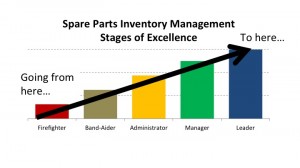 Defining best practice for spare parts management can be tough.
Defining best practice for spare parts management can be tough.
In fact, our recent research identified that, among the people that manage spare parts inventory, very little is known about best practices – that is, what top performers do better than others, what to focus on for better results and so on.
Of course one problem with defining best practice is that it may be possible to define a ‘best practice’ for almost everything that you do but implementing these practices may not actually make a difference to your overall results.
Another problem is that discussions on defining best practice are usually not objective – for many people best practice comes down to their own personal experience and opinion.
To overcome these problems we developed an approach that identifies which actions actually make a difference in terms of producing better spare parts inventory management outcomes.
Using this approach we identified 5 ‘best practices’.
Let Me Explain How We Set About Defining Best Practice
Some years ago we developed a method for evaluating and comparing the spare parts management performance of companies.
We call this the Materials and Spare Parts Management Matrix or simply the Best Proactive Matrix.
This matrix evaluates 25 aspects of spare parts management and we plot a company’s current performance against four escalating levels of performance using standardized descriptors.
Over the years this tool has been used to evaluate hundreds of storerooms and warehouses, in many different industries and countries, so we have a significant database of results.
For defining best practice we compared the management actions of the companies that scored well in terms of outcomes with those companies that didn’t score so well with outcomes.
By correlating outcomes in terms of inventory levels, stock turns and stock outs with a range of inventory management actions this tool gives us unique insights into what works and what doesn’t with spare parts management.
Not just what some companies are doing better than others but what actually makes a difference.
The matrix already helps in defining best practice in each aspect of spare parts management so what we have been able to do is extend this to identify the practices that make a real difference to the actual results.
For example, while many storeroom and warehouse managers focus on infrastructure and transaction management our analysis shows that, while important, improved management of transactions and good housekeeping are not sufficient when it comes to delivering ‘best practice’ results. Certainly not to be ignored but enough to deliver top results.
So just what does deliver ‘best practice’ outcomes?
As indicated above we have identified 5 best practices that make a genuine difference to spare parts management outcomes.
Pro Level members can follow these links to read about each one:
For information on our Pro Level membership please visit our Pro Level page.
Posted by: Phillip Slater